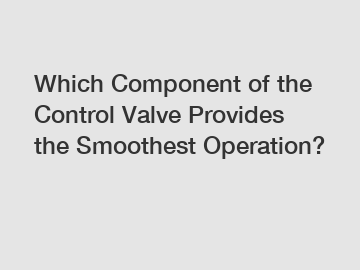Which Component of the Control Valve Provides the Smoothest Operation?
Which Component of the Control Valve Provides the Smoothest Operation?
In control valves, various components work together to regulate the flow of fluid in a system. However, when it comes to providing the smoothest operation, the valve trim plays a crucial role. The valve trim consists of different parts, including the plug, seat, and stem, which collectively determine the flow characteristics of the valve.
Valve trim design significantly impacts the performance of a control valve. Manufacturers carefully engineer the components to ensure precise control and minimal turbulence within the valve. The plug, which is attached to the valve stem, is the primary component responsible for modulating the flow. It moves within the seat, creating a variable opening that regulates the fluid passing through the valve.

To achieve the smoothest operation, the plug and seat interface must be carefully designed. The geometry, material selection, and surface finish of these components play a crucial role. A precisely machined plug with a streamlined shape can minimize any disturbances in the flow, resulting in smoother operation. Similarly, the seat, which acts as a seal, needs to provide a tight closure to prevent leakage and maintain control accuracy.
Furthermore, the stem design also contributes to the smooth operation of the control valve. The stem connects the actuator to the plug and transfers the movement from the actuator to the plug. A well-designed stem ensures precise positioning of the plug, reducing any potential oscillations or jerky movements during operation.
The smooth operation of a control valve is essential for several reasons. First and foremost, it allows for accurate control of the fluid flow, ensuring stability and efficiency of the overall system. Smooth operation reduces the chances of cavitation, pressure drop, and vibration, which can negatively impact the performance and longevity of the valve. Additionally, it enhances the control valve's ability to handle varying flow rates and pressure differentials, making it suitable for a wide range of applications.
The smooth operation of control valves also has significant implications for various industries. In the oil and gas sector, for example, control valves play a critical role in regulating the flow of crude oil through pipelines. Smooth operation ensures the smooth transportation of oil, minimizing the risk of pressure fluctuations and potential pipeline damages. Similarly, in the chemical industry, precise control of fluid flow is essential for maintaining the desired reaction rates and product quality.
In conclusion, the valve trim, consisting of the plug, seat, and stem, is the component that provides the smoothest operation in a control valve. Through careful design and engineering, manufacturers optimize the geometry, material selection, and surface finish to minimize disturbances in the flow. The smooth operation of control valves ensures accurate control, improves system stability, and has significant implications for various industries.
Want more information on directional servo valves suppliers, directional servo valves suppliers, Electro Hydraulic Directional Valve Factory? Feel free to contact us.

Comments
0